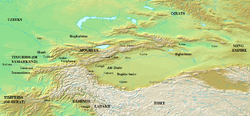Mogulistan

Mogulistan , Moghulistan , Mogolistan or Mongolistan is a geographical term that means 'land of the Mongols' and was used by the Persians from the 13th century for the western part of the Chagatai Khanate in Central Asia .
location
Mogulistan extends in the north to the Tarbagatai Mountains , in the west to Lake Issykköl and Lake Balkhash , in the east to the Altai Mountains, in the south to the oases of the Uighurs . Basically, the entire Tian Shan Mountains of northern Xinjiang , the Tschüi and Talas rivers and the Fergana Valley can also be assigned to Mogulistan (ie Kazakhs and Kyrgyz ).
The Chagatai Khanate is usually divided into the Uyguristan , Alti Shahr (the land of the six cities - or Kashgaria) (i.e. Yarkant , Kashgar , Hotan , Aksu , Uqturpan , Yengisar ) with the Tarim Basin and the Mogulistan to the west the Seven Rivers land .
Today the eastern part of Mogulistan belongs to the Chinese province of Xinjiang , the western parts belong to Kazakhstan and Kyrgyzstan .
history
After the division of the Mongol Empire (from 1260), the Chagatai Khanate was established , which itself consisted of two parts. Mogulistan was originally under the administration of the Eastern Chagatai Khanate , Tughluq-Timur (1329 / 30-1363) was Khan of Mogulistan and from 1360 also Khan of the Chagatai Khanate. An important city was Almaliq , which flourished in the 13th and 14th centuries during Mongol rule. Almaliq was the city of a Karluken ruler who followed Genghis Khan early on , later the Mongolian Chagatai Khan maintained his army camp nearby. Coins were struck in the city in the 14th century.
In the 15th century , a large number of Uzbek nomads came under Abu'l-Chair Khan (1412–1468), followed by sultans from the Golden Horde , Kerey Khan and Janybek Khan , who came here. The rulers of the Eastern Chagatai Khanate , Esen Buqa II and Yunus Khan , ceded part of Mogulistan (Kuqibashi) to them and they established the Kazakh Khanate . The Chagatai Khanate was increasingly restricted to southern Xinjiang (Nanjiang). This area later became the Kazak Khanate of the Great Horde , whose inhabitants were Wusun , Kankalis , Dughlat , Jalayir and other tribes.
literature
- Fischer world history . tape 16 : Central Asia.
- René Grousset: The steppe peoples . Essen 1975.
See also
References and comments
- ↑ cf. Alti S̲h̲ahr (Encyclopaedia of Islam, Second Edition)
- ↑ Chinese Wushi
- ↑ Chinese Yingjisha
- ^ Jürgen Paul : Central Asia. S. Fischer, Frankfurt am Main 2012 (= Neue Fischer Weltgeschichte . Volume 10), p. 292.
- ↑ Chinese 库齐巴什, near the river Tschüi ; see. 360doc.com: Xinjiang lishi jianjie .
| Mogulistan (alternative names of the lemma) |
|---|
| Moghulistan; Moghulistan; Mughalistan; مغولستان; Dongchahetai hanhuo 东 察合台 汗国; Dōng Cháhétái Hànguó; Eastern Chagatai Khanate; Dong Chahetai hanguo |

